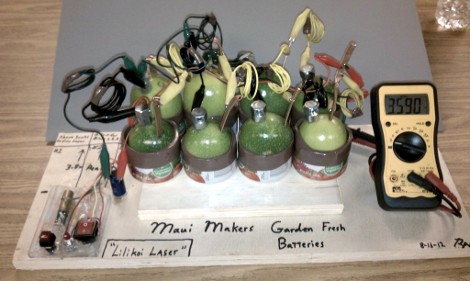
Apparently being overrun by ripe Passion Fruit is a problem if you live in Hawaii. [Ryan K’s] solution to the situation was to use his extra fruit to power a laser. In an experiment that would make [Walter White] proud, [Ryan] gathered everyday supplies to form a battery based on the fruit.
He used some galvanized bolts as the source of zinc. It forms one pole of each cell, with a thin copper tube as the other pole. Each cell is rather weak, but when combined with others it makes a respectable battery. We’ve seen acidic fruit used to power LEDs, but [Ryan] wanted to do a little more. He built a circuit that would store electricity until he had enough potential to power an LED diode. After the break you can see a four second clip of the fruit wielding its new laser defense system.
[Thanks Jerry]















this project too needs a mad-scientist “knife switch” XD
Why is this on hackaday? Only difference between this and a potato powered clock is a laser diode.
Wake me when someone does something on a much larger scale. Say a 6″ spark off a tesla coil or powers a blood thirsty AI off of a fruit/vegetable battery.
A trusted friend in science.
You answered your own question mate.
OK BRB. Going to make a baking soda volcano that utilizes passion fruit as the power source for some led light effects! NEW HACK! It’s mine! GROUND BREAKING INNOVATION.
Oh, its just a fruit powered laser, I thought it was some kind of DIY GMO.
I would be somewhat worried if they could GM food to have laser emitters.
No more stealing from my orchard, MUHAHAHAHA!
It’s frightening to imagine the creature that laser emitting genetics would come from to begin with.
It is not using the fruit to power the battery. It is using the fruit to supply the electrolyte for the battery. The redox reactions at the electrodes are where the power lies, not the electrolyte.
I’ve seen many science fair exhibits with batteries that use unconventional electrolytes, such as potatoes, lemons, seawater, etc. It’s a common mistake in the popular press to say that these are doing something like “getting energy from seawater”, or “energy from potatoes”. But the energy comes from the corrosion of the electrodes. The energy was originally put into the battery when the metal of the electrodes was refined. The expensive and energy-intensive part of a conventional battery isn’t the electrolyte, it’s the electrodes.
Yeah, and it’s a shame. Otherwise we could solve our energy problems AND remove the calories from our food at the same time! “I can eat all the bacon I want now! I just plug my phone into the fatty part and let it charge for a while…”
well i didnt know that!!!
Actually passion fruit (locally called poke) is a real problem here, the stuff keeps threatening to overrun my mango tree.
” He built a circuit that would store electricity until he had enough potential to power an LED diode.”
LED diode? :P
Light Emitting Diode diode? :P
LE (D^2)? :P
that is a common thing and is everywhere. example atm machine, pin number, lcd display and those are just a few theres many many more
Yeah, I was puzzled by this language, too: LED Diode? HIV Virus? ATM Machine? Really?
it remind me aperture science “bring your daughter at work” day…